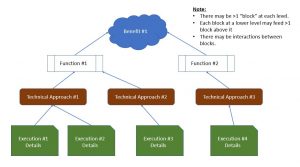I hope you enjoyed Part 1…now here’s Part 2 about “Functional Mapping”. Enjoy!

Finding Order in Chaos – Part 2
When we’re lost, a map can help us get back on track. In a prior article, I discussed the chaos that can ensue when a business needs to solve a problem and said, “If we can find order in the chaos, that helps solve problems faster, more efficiently.” I also said “Functional Mapping” is very helpful in solving technical problems. So, “what’s a ‘functional map’…?”
I’ve found problems have many levels and different people tend to focus on different levels. When one person is talking about 1 level and another is talking about a different level – we often talk past each other or struggle to understand each other.
“Functional Maps” shows these levels to create a framework for all to understand the problem in detail. When we share it and invite others to understand and expand on it, this really engages others & builds ownership in finding a solution. It also expands the possible solution space and invites new solutions.
I break down problems and systems related to it into 4 levels: Benefits, Functions, Technical Approaches, and Executional Details (Details, for short). I’ll bring these levels to life with an example.
One “Benefit” of a car is that it gets us from “point A to point B” (without walking or riding a horse).
Many “Functions” (i.e. accelerating to & maintaining a speed) must be delivered to enable the benefit.
There can be various “Technical Approaches” for achieving each function. For example, the engine that provides power to accelerate and maintain speed could be internal combustion or electric.
Within a technical approach, there can many different executions that can be described with “Details”, such as the engine’s size, number of cylinders, the materials used, etc. A full set of “Details” about a car would enable making a drawing of the car and describe its composition or formula.
The map looks like a flowchart with a series of “blocks” connected with lines. See a very simple example to right or Click for larger version: 
Imagine we’ve created such a map, share it with others, and pinpoint where the problem lies. The problem may be that a certain function is not delivered sufficiently to enable the benefit consumers desire. Or, that the technology chosen is inherently limited in how well it can deliver a function. Or, that a particular detail limits results. Or, it could be that the benefit is not even relevant to consumers, so we need to focus on a different one! Whatever it is, this focuses everyone on the same problem.
Also, when others see the map, they may suggest expanding it. They might propose other technical approaches to deliver the function (i.e., using a “fuel cell engine” instead of internal combustion), other functions to enable the benefit, or alternative designs (details) which make the current technology work better. This engages others & expands our thinking to new solution spaces.
To get to a solution, we may choose pathways at differing levels. For example, we may pursue a short-term solution by optimizing executional details within a current technical approach in parallel with a longer-term solution of changing the technical approach. Choosing to deliver an all new benefit may require new functions and/or technical approaches or a radical redesign.
The concept of the map is simple but creating one and using it effectively takes practice. In future articles, I’ll give examples of using them. Also, this is an area in which I can help my clients – creating and using such maps effectively.
To learn more Contact Mark
Mark Kline, October 2018
